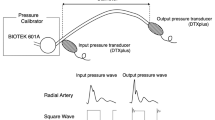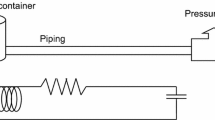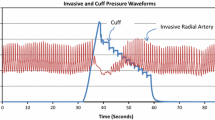Abstract
A system for online compensation and differentiation of blood-pressure pulse waves was developed which compensates for pressure-waveform distortion due to transmission, in fluid-filled catheters and provides outputs of pressure P,\(\dot P\), P/\(\dot P\) and\(\dot P\). The compensator can be tuned with the catheter in place by changing the natural frequency and damping ratio when these catheter parameters are altered by fibrin deposits, gas bubbles, and softening of the catheter wall. The compensator can be used with standard monitoring equipment and its output can be recorded or displayed on a cathode-ray-tube oscilloscope.
Sommaire
On a développé un système pour compenser et différencier en circuit les ondes de pulsation de pression sanguine. Ce système compense les distorsions d'ondes de pression causées par les transmissions dans les cathéters remplis de fluide et donne des rendements de pression P. P, P/P et P. Le compensateur peut être réglé avec le cathéter en position en changeant la fréquence naturelle et le rapport d'atténuation lorsque ces paramètres de cathéter sont modifiés par des dépôts de fibrine, des bulles de gaz et l'amolissement de la paroi du cathéter. Le compensateur peut être utilisé avec de l'appareillage normal de contrôle et sa sortie peut être enregistrée ou affichée sur un oscillographe cathodique.
Zusammenfassung
Es wurde ein System zum direkten Ausgleich und zur Unterscheidung von Blutdruck-Impulswellen entwickelt, bei dem die Druckwellenformverzerrung durch Übertragung in mit Flüssigkeit gefüllten Kathetern ausgeglichen wird, und durch das man die Durckwerte P, P, P/P und P erhält. Der Kompensator kann mit dem angebrachten Katheter abgestimmt werden, indem man die natürliche Frequenz und das Dämpfungsverhältnis abwandelt, wenn sich diese Katheterparameter durch Fibrinablagerungen, Gasblasen und Erweichen der Katheterwände ändern. Der Kompensator kann mit standardmäßigen Überwachunsgeräten angewandt werden. Seine Ausgabewerte können aufgezeichnet oder auf einem Oszilloskop mit Kathodenstrahlröhre angezeigt werden.
Similar content being viewed by others
References
Bottaccine, M. R., Burton, D. L. andLim, T. P. K. (1967) Calibration of high-frequency manometers with the shock tube.J. Appl. Physiol. 22, 832–835.
Dear, H. D. andSpear, A. F. (1971) Accurate method for measuringdp/dt with cardiac catheters and external transducers.Ibid.,30, 897–899
Fry, D. L. (1960) Physiologic recording by modern instruments with particular reference to pressure recording.Physiol. Rev. 40, 753–788.
Geddes, L. A. (1970)The direct and indirect measurement of blood pressure. Year Book Medical Publishers Inc., Chicago.
Grossman, W., Brooks, H., Meister, S., Sherman, H. andDexter, L., (1971) New technique for determining instantaneous myocardial force-velocity relations in the intact heart.Circ. Res. 28, 290–297
Hauge, O. (1968) Electrical-analog compensation for dynamic signal distortion: the general case and cardiac catheter. Master's thesis, University of Washington.
Knopp, T. J., Rahimtoola, S. H. andSwan, H. J. C. (1965) First derivative of ventricular pressure recorded with conventional cardiac catheters.Circulation 32, Suppl. II, 128.
Kuo, C. (1964)Automatic control systems Prentice Hall Inc., Englewood Cliffs, NJ, 126–130.
Latimer, K. E. (1968) The transmission of sound waves in liquid-filled catheter tubes used for intravascular blood pressure recording,Med. & Biol. Engng. 6, 29–42.
Latimer, K. E. andLatimer, R. D. (1969) Measurements of pressure-wave transmission in liquid-filled tubes for intravascular blood-pressure recording.Med. & Biol. Engng. 7, 143–168.
Mankelow, R. T. andBaird, R. J. (1969) A practical approach to accurate pressure measurements.J. Thorac. Cardiovasc. Surg. 58, 122–127.
Mason, D. T. (1969) Usefulness and limitations of the rate of rise of intraventricular pressure (dp/dt) in the evaluation of myocardial contractility in man.Am. J. Cardiol. 23, 516–527.
Melbin, J. andSpohr, M. (1969) Evaluation and correction of manometer systems with two degrees of freedom.J. Appl. Physiol. 27, 749–755.
Neal, J. J. Jun., Halperin, W. andReeves, T. J. (1960) Velocity and acceleration of pressure change in heart and arteries.Ibid. 15, 747–749.
Nejad, N. S., Klein, M. D., Mirsky, I. andLown, B. (1971) Assessment of myocardial contractility from ventricular pressure recordings.Cardiovasc. Res. 5, 15–23.
Noble, F. W. (1952) A hydraulic pressure generator for testing the dynamic characteristics of blood pressure manometers.J. Lab. & Clin. Med. 54, 897–902.
Noble, F. W. andBarnett, G. O. (1963) An electric circuit for improving the dynamic response of the conventional catheter system.Med. Electron. Biol. Engng. 1, 537–535.
Noble, F. W. (1957) The sonic valve pressure gauge.IRE Trans. PGME 8, 38–45.
Shapiro, G. G. andKorvetz, L. J. (1970) Damped and underdamped catheter manometer systems.Am. Heart J. 80, 226–236.
Stegall, H. F. (1967) A simple, inexpensive sinusoidal pressure generator.J. Appl. Physiol. 22, 591–592.
Vierhout, R. R. andVendrik, A. J. H. (1961) A hydraulic pressure generator for testing the dynamic characteristic of catheters and manometers.J. Lab. & Clin. Med. 58, 330–333.
Wood, E. H. (1956) Physical response requirements of pressure transducers for the reproduction of physiological phenomena.Electr. Eng. 75, Pt. 1, 32–40.
Yanof, H. M., Rosen, A. L., McDonald, N. M. andMcDonald, D. A. (1963) A critical study of the response of manometers to forced oscillations.Phys. Med. Biol. 8, 407–422.
Author information
Authors and Affiliations
Rights and permissions
About this article
Cite this article
Damenstein, A., Stout, R.L., Wessel, H.U. et al. Electronic compensator for pressure waveform distortion by fluid-filled catheters. Med. & biol. Engng. 14, 186–192 (1976). https://doi.org/10.1007/BF02478746
Received:
Accepted:
Issue Date:
DOI: https://doi.org/10.1007/BF02478746




